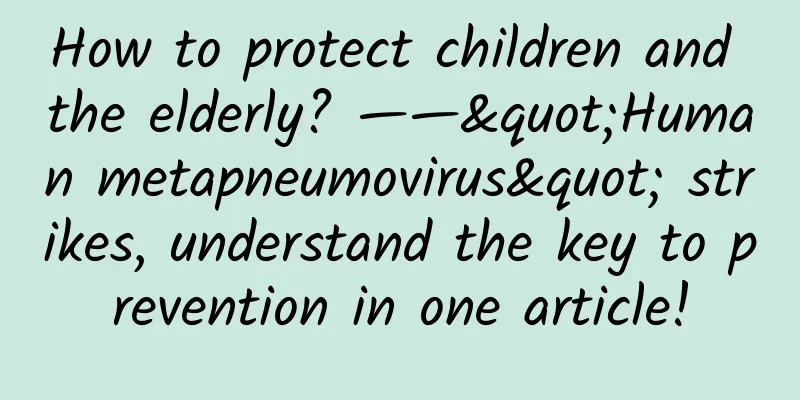How to protect children and the elderly? ——"Human metapneumovirus" strikes, understand the key to prevention in one article!

|
Recently, the term human metapneumovirus has been frequently searched, attracting the attention and concern of many people, especially parents. So, what exactly is human metapneumovirus? How much of a threat does it pose to our health? How can we prevent its infection? Next, let us learn about this new virus that has been discovered not too long ago. Human metapneumovirus (hMPV) is a common respiratory virus belonging to the genus Metapneumovirus of the family Paramyxoviridae. It is an enveloped single-stranded negative-sense RNA virus that mainly infects humans, especially children, the elderly and people with weak immune systems. In 2001, Dutch scholars first discovered it in the nasopharyngeal secretions of children with respiratory infections. Although it was discovered not long ago, it has been spreading among the population for a long time, threatening our health. Mode of transmission 1. Droplet transmission is the main mode of transmission. The droplets produced by the patient's coughing and sneezing contain viruses, which can cause infection when inhaled by others. The wind I blew over you this time cannot be considered a hug, it can only be considered an infection! (snickering) Image source: Pixabay 2. Transmission through close contact, such as contact with hands or objects contaminated by the virus and then contact with the mouth, nose, eyes and other mucous membranes. Hehe, if you hold my hand and walk into tomorrow's storm, you will definitely be infected! (Snickering quadratically) 3. The risk of transmission is higher in closed environments (such as kindergartens, nursing homes, hospitals, etc.). The similarities between close friends living together are that they all have the same disease! (Snickering to the third power) Symptoms of infection Similar to the common cold or flu, common symptoms include cough, fever, nasal congestion, runny nose, sore throat, etc. In severe cases, it can cause lower respiratory tract infections such as bronchitis, pneumonia, and bronchiolitis. The symptoms in adults are relatively mild, while those in infants, the elderly, and people with immune deficiencies may be more severe. Popular features The epidemic season overlaps with that of influenza and other respiratory viruses, and is more common in winter and spring. The general population is susceptible, and infants, the elderly, and people with weakened immune systems often have more severe symptoms and recover more slowly once infected.
Diagnosis and treatment 1. The diagnosis can be confirmed through preliminary clinical symptoms, combined with nucleic acid testing, antigen testing and serological testing of nasopharyngeal swabs, sputum and other specimens. 2. Currently, there is no specific antiviral drug for human metapneumovirus. The main treatment is symptomatic support, such as antipyretic, antitussive, antiasthmatic, oxygen inhalation, etc. Severe cases may require mechanical ventilation. Therefore, prevention is particularly important. Precautions Although there is currently no vaccine for hMPV, we are not completely defenseless when facing human metapneumovirus. 1. Personal daily protective measures Wash your hands frequently, with soap and running water after touching public items, coughing or sneezing. When it is inconvenient to wash your hands, using alcohol-based hand sanitizer is also a good choice. Try to avoid touching your eyes, nose and mouth with your hands to reduce the chance of the virus entering the body. Wearing a mask in public places or when in contact with suspected infected people can effectively reduce the risk of droplet transmission. Cover your mouth and nose with a tissue or elbow when coughing or sneezing, and avoid using your hands directly. 2. Environmental cleaning and disinfection Regularly use chlorine-containing disinfectants or alcohol to disinfect high-frequency contact surfaces: such as door handles, desktops, mobile phones, keyboards, etc. Keep indoor ventilation to reduce the virus concentration in a closed environment. 3. Social distance and isolation During the high incidence season of hMPV, try to avoid crowded places, and wear a mask when necessary. If you have symptoms of respiratory infection, you should seek medical attention in time, rest at home as much as possible, and avoid contact with others. 4. Protect vulnerable groups Infants, the elderly and those with immunodeficiency are more likely to develop severe illness after infection and should try to avoid contact with people with symptoms of respiratory infections. 5. Health education Through publicity and education, public awareness can be raised to let the public know about the transmission routes, symptoms and prevention measures of hMPV. Although there is currently no vaccine against hMPV, vaccination against influenza and pneumonia can reduce the risk of co-infection. Summarize hMPV is a common respiratory virus. Although most infected people have mild symptoms, it may cause serious health problems for high-risk groups. It sounds scary, but as long as we understand its characteristics and take preventive measures, there is no need to panic. If suspected symptoms occur, seek medical attention in time and take isolation measures. Let us start with the little things in life to protect the respiratory health of ourselves and others. Contributor: Chongqing Science Writers Association Writer: Tang Changyan, attending physician of Chongqing Dazu District Center for Disease Control and Prevention, and Zou Jingbo, chief technician of Zou Science Garden. Review expert: Li Hanbin Statement: Except for original content and special instructions, some pictures are sourced from the Internet for non-commercial purposes and are only used as popular science materials. The copyright belongs to the original author. If there is any infringement, please contact us to delete it. |
Recommend
[Beauty and Skin Care] Why do I get acne between my eyebrows? What should I do if I have acne between my eyebrows?
Acne is something that women who love beauty hate...
Fatigue, memory loss... Is it because your brain is not working enough? Huaxi doctors: Be careful after this age!
I wonder if you have ever missed the past? Recent...
What are the causes of blood in women's urine?
Blood in urine, as the name suggests, means that ...
What causes a woman's genitals to smell fishy?
Many women want to make their figures more promin...
Exercise that helps with production
Nowadays, there are many exercises that can help ...
Pregnancy during the month of Chinese medicine enema
Chinese medicine enema is a relatively common tre...
What kind of sanitary napkin is good for girls?
Girls who are entering puberty are about to have ...
Will it hurt for women to have their IUD removed?
Our country adheres to the basic national policy ...
Is it necessary to do a biopsy if the TCT is normal?
With the emergence of various diseases and the in...
Zhou Haimei's cause of death announced! Beware of the signs of a heart "strike", especially for those living alone!
Recently, Zhou Feng, the sister of the famous act...
How effective are granular condoms?
Granular condoms are made of high-quality pure na...
Tea for women during menopause
One-third of a woman's life will be spent aft...
Go exercise in the spring, but be careful, the harder you exercise, the more "injured" you will be...
Take off the down jacket! The woolen coat is off!...
How to treat female sexual frigidity?
People often talk about sexual apathy, which refe...

![[Medical Q&A] Why shouldn't patients with liver cirrhosis eat too much pasta and sweets for dinner?](/upload/images/67f118e89ab05.webp)







